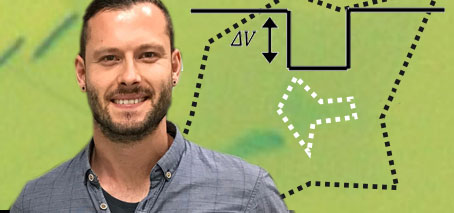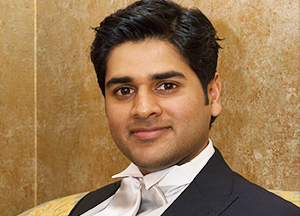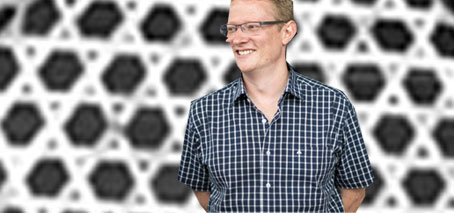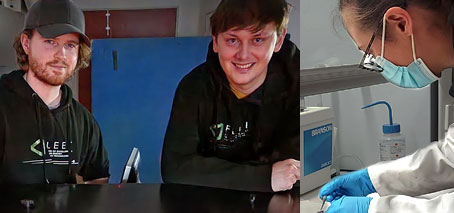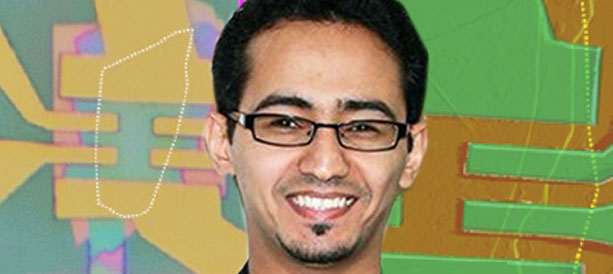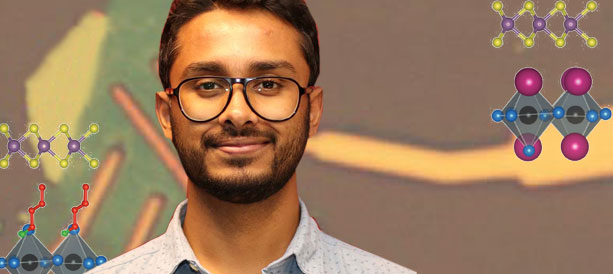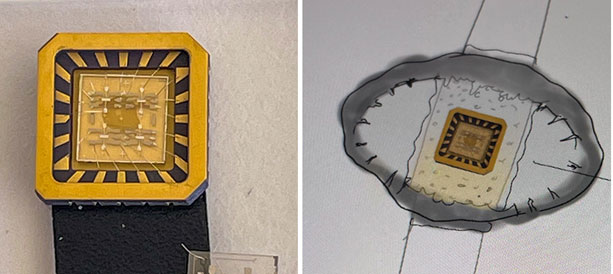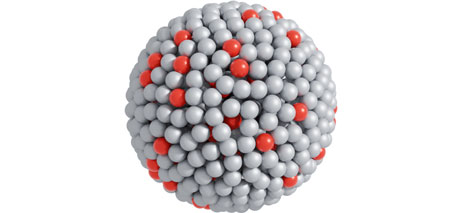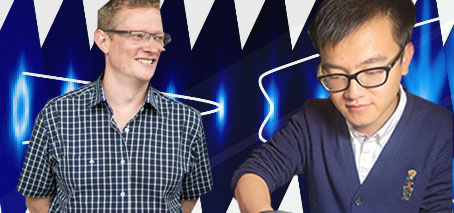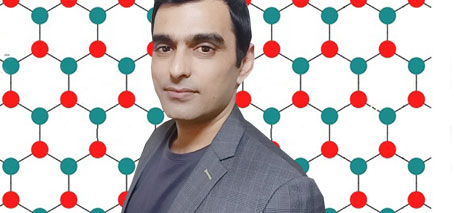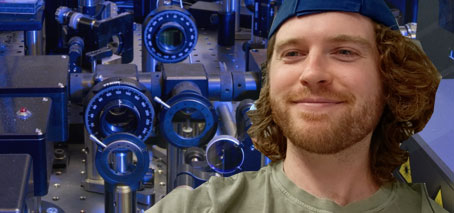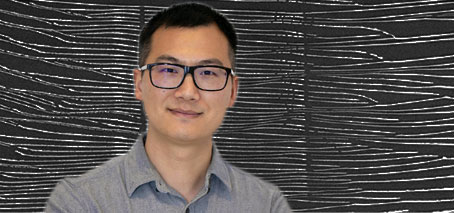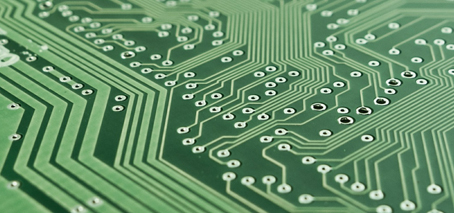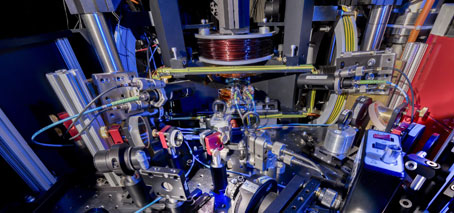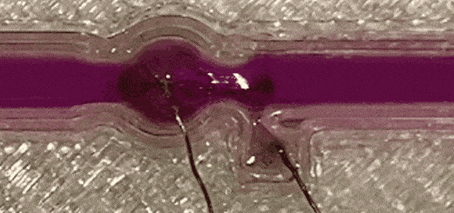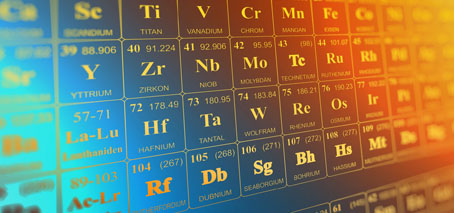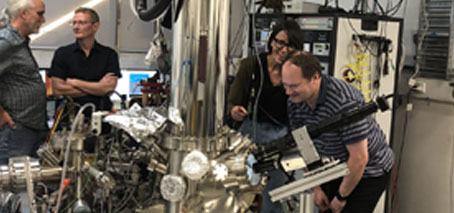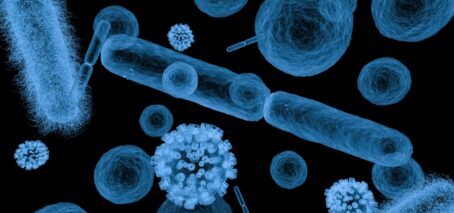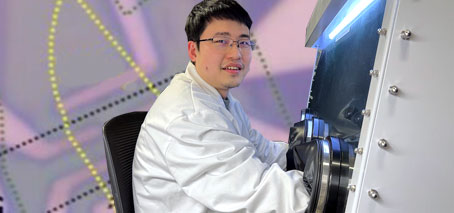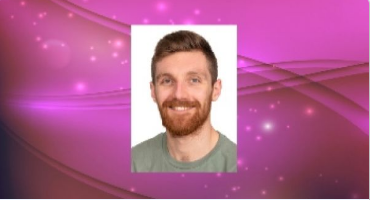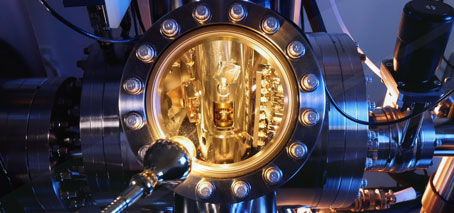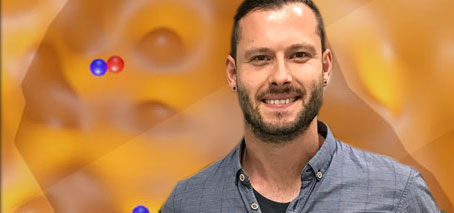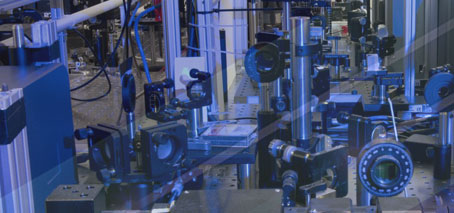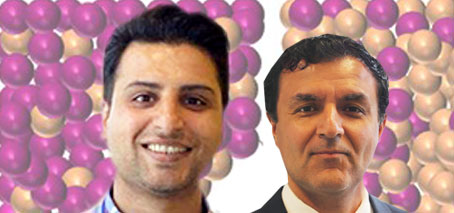High exciton-polariton density in an engineered quantum box Possible pathway to future, ultra energy-efficient technologies Australian researchers have engineered a quantum box for polaritons in a two-dimensional material, achieving large polariton densities and a partially ‘coherent’ quantum state. New insights coming from the novel technique could allow researchers to access striking ‘collective’ quantum phenomena in this material family, and enable …
New Chief Investigator Priyank Kumar
Congratulations to Priyank Kumar at the School of Chemical Engineering, UNSW Sydney, who becomes a new Chief Investigator within FLEET. “I look forward to contributing to the objectives of FLEET through both fundamental and translational research,” said Priyank. “I would like to thank Michael Fuhrer, Kourosh Kalantar-zadeh and the FLEET team for providing me this opportunity.” Priyank has been an …
Future Fellowship Mark Edmonds
Kagome metals: From Japanese basket to next generation electronic devices FLEET AI Dr Mark Edmonds received an ARC Future Fellowship in this week’s announcement by the Minister. The new ARC Fellowship will support Mark’s work investigating a new type of 2D material that is very promising for faster, more energy-efficient future electronic devices. ‘Kagome’ metals have a topological non-trivial nature …
What you see is what you get with pre-characterised TMDs: FLEET Translation Program
First project approved for FLEET Translation Program funding PhD candidates Mitch Conway, Abby Goff, and Jack Muir have recently been awarded $31,000 in FLEET’s first round of funding from the FLEET Translation Program (FTP). Their cross-node collaboration between Swinburne and RMIT aims to create a catalogue of high quality 2D materials, namely transition metal dichalcogenides (TMDs) and their heterostructures. …
Manipulating interlayer magnetic coupling in van der Waals heterostructures
Electrical control of exchange bias effect in FePS3-Fe5GeTe2 van der Waals heterostructures via proton intercalations A RMIT-led international collaboration published this week has observed, for the first time, electric gate-controlled exchange-bias effect in van der Waals (vdW) heterostructures, offering a promising platform for future energy-efficient, beyond-CMOS electronics. The exchange-bias (EB) effect, which originates from interlayer magnetic coupling, has played a …
The hetero-interface is the device: a computational approach
Designing hetero-interfaces towards new optoelectronic functionalities using large-scale computations Assembling ‘Lego-like’ 2D ‘heterostructures’ can give rise to emergent properties and functionalities very different from the intrinsic characteristics of the constituents. Density functional theory (DFT)-based band-structure calculations can shed light on interfacial properties of different heterostructures. Interface properties of 2D perovskite/TMD heterostructures Heterostructures based on different 2D materials have resulted in …
Brilliant alternative uses for diamond showcased in concept jewellery
QUT/FLEET researcher A/Prof Dongchen Qi has joined forces with an Australian jewellery designer to showcase the brilliance of diamond in medical, scientific, and other applications. Diamond does not naturally conduct electricity, but Professor Qi, from the QUT Centre of Material Science, led research to make it both conductive and controllable as a high-capacity semiconductor. Semiconductors conduct or insulate electrical signals …
Topological superconductors: fertile ground for elusive Majorana particle
Majorana fermions promise information technology with zero resistance A new, multi-node FLEET review investigates the search for Majorana fermions in iron-based superconductors. The elusive Majorana fermion, or ‘angel particle’ proposed by Ettore Majorana in 1937, simultaneously behaves like a particle and an antiparticle – and surprisingly remains stable rather than being self-destructive. Majorana fermions promise information and communications technology with …
Liquid platinum at room temperature: The ‘cool’ catalyst for a sustainable revolution in industrial chemistry
In an Exciton Science/FLEET study, researchers have been able to use trace amounts of liquid platinum to create cheap and highly efficient chemical reactions at low temperatures, opening a pathway to dramatic emissions reductions in crucial industries. When combined with liquid gallium, the amounts of platinum required are small enough to significantly extend the earth’s reserves of this valuable metal, …
Making a ‘sandwich’ out of magnets and topological insulators, potential for lossless electronics
Designer heterostructure is a potential high-temperature QAHE, where a topological material is sandwiched between two ferromagnets A Monash University-led research team has discovered that a structure comprising an ultra-thin topological insulator sandwiched between two 2D ferromagnetic insulators becomes a large-bandgap quantum anomalous Hall insulator. Such a heterostructure provides an avenue towards viable ultra-low energy future electronics, or even topological photovoltaics. …
Together we’re stronger: developing a new layered material for future electronics
A new RMIT-led study stacks two different types of 2D materials together to create a hybrid material providing enhanced properties. This hybrid material possesses valuable properties towards use in future memory and electronic devices such as TVs, computers and phones. Most significantly, the electronic properties of the new stacked structure can be controlled without the need for external strain, opening …
A zigzag blueprint for topological electronics
A collaborative study led by the University of Wollongong confirms switching mechanism for a new, proposed generation of ultra-low energy ‘topological electronics’. Based on novel quantum topological materials, such devices would ‘switch’ a topological insulator from non-conducting (conventional electrical insulator) to a conducting (topological insulator) state, whereby electrical current could flow along its edge states without wasted dissipation of energy. …
Bonding exercise: quantifying biexciton binding energy
Two-quantum multidimensional coherent spectroscopy (2Q-MDCS) quantifies precise biexciton binding energy Applications in future devices based on biexcitons in TMDCs A rare spectroscopy technique performed at Swinburne University of Technology directly quantifies the energy required to bind two excitons together, providing for the first time a direct measurement of the biexciton binding energy in WS2. As well as improving our fundamental …
Superfluids provide new insight into turbulence
First published at EQUS: the ARC Centre of Excellence for Engineered Quantum Systems Eddies in an exotic liquid known as a superfluid merge to form large vortices, analogous to how cyclones form in the turbulent atmosphere. The new research, by a team from The University of Queensland, EQUS and FLEET will be important for emerging technological applications of superfluidity, such …
Liquid metals, surface patterns, and the Romance of the Three Kingdoms
“The long divided, must unite; long united, must divide. Thus it has ever been.” The opening lines of the great Chinese historical novel Romance of the Three Kingdoms condense its complex and spectacular stories into a coherent pattern, that is, power blocs divide and unite cyclically in turbulent battle years. A good philosophy or theorem has general implications. Now, published …
Beyond scifi: Manipulating liquid metals without contact
In a landmark discovery, FLEET University of Wollongong (UOW) researchers have realised the non-contact manipulation of liquid metal. The metals can be controlled to move in any direction, and manipulated into unique, levitated shapes such as loops and squares by using a small voltage and a magnet. The liquid metal used is galinstan, an alloy of gallium, indium and tin, …
Trapping vortices in thin superfluid films
Physicists at the University of Queensland have shed light upon how tiny whirlpools (vortices) get stuck to obstacles in superfluids. Superfluids are a quantum substance that can flow without viscosity and hence do not slow down due to friction. A second defining feature of superfluids is that they only support quantised rotation – the vortices can only spin with strength …
Negative capacitance in topological transistors could reduce computing’s unsustainable energy load
Australian researchers have discovered that negative capacitance could lower the energy used in electronics and computing, which represents 8% of global electricity demand. The researchers at four universities within the ARC Centre of Excellence in Future Low-Energy Electronics Technologies (FLEET) applied negative capacitance to make topological transistors switch at lower voltage, potentially reducing energy losses by a factor of ten …
Probing quantum gases with spectroscopy (Nature review)
December’s edition of Nature Physics is dedicated to ultracold quantum technologies, including a review of spectroscopic probes of quantum gases by FLEET’s Chris Vale (Swinburne), with MIT’s Martin Zwierlein. Ultracold gases are a laboratory for precision, many-body physics – delivering a wealth of insights into collective quantum phenomena, with direct implications for nuclear and condensed-matter physics. Spectroscopic techniques can probe …
Losing isn’t always bad: gaining topology from loss
Generating topology from loss in hybrid light-matter particles Observation of new non-Hermitian topological invariant in exciton-polariton system Losing particles can lead to positive, robust effects. An international collaboration has demonstrated a novel topology arising from losses in hybrid light-matter particles, introducing a new avenue to induce the highly-prized effects inherent to conventional topological materials, which can potentially revolutionise electronics. Led …
No more moving parts: Liquid metal enabled chemical reactors
Liquid-metal machines could wipe out maintenance issues for continuous flow reactors. Metals that are liquid at room temperature, such as gallium and its alloys, are attractive materials due to their unique electrical, thermal and fluidic properties. In a study published today, a research team led by UNSW, Sydney has shown that liquid metals can offer their characteristics to the pharmaceutical and chemical …
Having your cake and eating it too: double-dosing induces magnetism while strengthening electron quantum oscillations in a topological insulator
Harnessing massive Dirac fermions in dual-magnetic-ion-doped Bi2Se3 topological insulator showing extremely strong quantum oscillations in the bulk. Double doping induces a gap for the topological surface state. A University of Wollongong-led team across three FLEET nodes has combined two traditional semiconductor doping methods to achieve new efficiencies in the topological insulator bismuth-selenide (Bi2Se3), Two doping elements were used: samarium (Sm) …
Welcoming Simon Granville (MacDiarmid) new FLEET Partner Investigator
Welcome to FLEET’s long-time collaborator Dr Simon Granville, who this month joins the Centre as a Partner Investigator. Simon is a Principal Investigator at FLEET’s partner organisation the MacDiarmid Institute for Advanced Materials and Nanotechnology, where he leads the Institute’s Future Computing project to control electron transport and spin through superconductivity and topology. As a Senior Scientist at the Robinson …
World record broken for thinnest X-ray detector ever created
Highly sensitive and with a rapid response time, the new X-ray detector is less than 10 nanometres thick and could potentially lead to real-time imaging of cellular biology. Exciton Science and FLEET researchers have used tin mono-sulfide (SnS) nanosheets to create the thinnest X-ray detector ever made, potentially enabling real-time imaging of cellular biology. X-ray detectors are tools that allow …
Quantifying spin in WTe2 for future spintronics
Spin-momentum locking induced anisotropic magnetoresistance in monolayer WTe2 Determining spin quantization axis, an essential element for fabricating spintronic devices, in 2D topological insulator WTe2 by measuring anisotropic magnetoresistance A RMIT-led, international collaboration published this week has observed large in-plane anisotropic magnetoresistance (AMR) in a quantum spin Hall insulator and the spin quantization axis of the edge states can be well-defined. …
Cheering on FLEET’s Mitko Oldfield in the International Visualise Your Thesis
Stress can be good for you: enhancing piezoelectric properties under pressure
Innovative epitaxy technique creates a new phase of the popular multiferroic BiFeO3 Stress enhances the properties of a promising material for future technologies. UNSW researchers find a new exotic state of one of the most promising multiferroic materials, with exciting implications for future technologies using these enhanced properties. Combining a careful balance of thin-film strain, distortion, and thickness, the team …
Sandwich-style construction: towards ultra-low-energy exciton electronics
New microcavity construction technique allows observation of robust, room-temperature exciton transport Polariton performance optimised by maximising photon-exciton energy exchange, minimizing the damage to monolayer A new ‘sandwich-style’ fabrication process placing a semiconductor only one atom thin between two mirrors has allowed Australian researchers to make a significant step towards ultra-low energy electronics based on the light-matter hybrid particles exciton-polaritons. The …
Ultra-short or infinitely long: it all looks the same
Driven states in WS2 monolayers unable to discriminate between ultrashort pulses of light and an infinite, continuous drive Ultrashort pulses of light can adiabatically drive transitions to new Floquet phases of matter Ultrashort pulses of light are proven indistinguishable from continuous illumination, in terms of controlling the electronic states of atomically-thin material tungsten disulfide (WS2). A new, Swinburne-led study proves …
Elements in liquid metals compete to win the surface
Some alloys are in the liquid state at or near room temperature. These alloys are usually composed of gallium and indium (elements used in low energy lamps), tin and bismuth (materials used in constructions). The ratio and nature of elements in liquid alloys generate extraordinary phenomena on the surface of liquid metals which have been rarely explored to date and …

